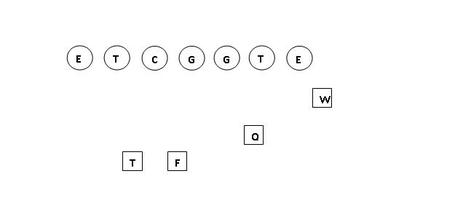Back in the Spring, at the suggestion of Aerobab, our favorite officer-in-training, a few of us tried to meet up at the Orange and White game for a get-together and a chance to see Clawson's new offense (or at least a few hints at it). We very quickly learned that we're not all that good at coordinating a get-together amongst people who've never met, but Joel, Aerobab and I managed to find each other and get prime seats in the end zone. During the game, we saw some outstanding play from the first team on both sides of the ball - particularly from the Berry/Morley duo.
But one moment caught my eye in particular...
Note the 0:54 mark in the above video. You can't really see the formation from the camera angle, but it's a Single Wing. Crompton was split out wide, safely away from anything resembling contact. Jones took the snap and passed for a TD to Denarius Moore. To be fair, the play looked a lot like a running play - a sweep - which allowed Moore to get behind the defense. But the use of the Single Wing formation was quite intentional by Clawson, and there may be more to learn of the upcoming UT offense from that one play than it may seem.
So with those few seconds of a single play, I decided to read up on the Single Wing and try to see a little more what Clawson was experimenting with. Let's face it: other than some grainy pictures of Neyland's teams and the "cloud of dust" reputation, few people know much about the Single Wing. Yet Clawson just used it for a long pass from Jones - something that Cutcliffe never even attempted last year.
Before exploring the Single Wing with regards to 2008 UT football, a question must first be answered: what is the Single Wing? In short, the Single Wing was the dominant offensive formation in the first half of the twentieth century. Due to its relative lack of use in recent times, however, the formation is not particularly familiar to most fans anymore. So before I look at its implications for the upcoming season, let me review the basics of the formation and how it differs from modern formations. As with all things football, pictures tell all:
The above picture shows the offensive formation that is perhaps the archetypical Single Wing formation. The linemen are in circles and the backfield players are in squares (as if you didn't already figure that out, I know, but it doesn't hurt to point out that I'll stick with that convention). The abbreviations for the linemen are: C = Center, E = End, G = Guard and T = Tackle. The abbreviations for the backfield are: F = Fullback, Q = Quarterback, T = Tailback and W = Wingback. Other than the lack of wide receivers, this formation has 4 features that are almost never seen in modern (read: pro-style) offenses. Can you guess what they are? I'll explain after the pretty picture that follows (which, if you've scanned ahead, gives away much of it).
Figure 2 - Key Positions in the Single Wing
Ok, the answers:
1. The Center is not between the Guards. This is known as an unbalanced line formation, whereas formations with the center between the guards are known as balanced line formations. (Gee, those football term-makers are creative...)
2. The Quarterback is not behind the Center. In the traditional Single Wing, the Quarterback was usually a blocking back while the Tailback or Fullback received the snap. The Quarterback, however did have the playcalling responsibilities that the modern quarterback has. (This is the main reason why our modern quarterbacks are still called quarterbacks. When the T-formation was created, the quarterback was moved behind center where to coordinate the playcalling with the new-fangled direct snap.) At any rate, remember that the Single Wing was born in an era of run-first (and second and third and ... nth) football; passing came into the formation as a matter of evolution rather than initial design.
3. Neither the Tailback nor the Fullback are lined up directly behind the Center. The center would snap to either ‘back, depending on the play call. More on this in a bit.
4. The Wingback. In pro-set offenses, you don't commonly see somebody lined up behind the tight end. Even the slot receiver is usually a fair distance to the side of the line in order to spread the defense and open up some running room.
At this point, it's a good idea to notice how much sense some position names make when seen in their historical context. Before the Single Wing, the Center truly was the Center of the formation. Guards were so named because they were the blocker who assisted the Center as he was recovering from the snap. Tackles were the guys who, when on defense, made most of the tackles (remember that early football required players to play both ways). Ends were simply the ends of the line, with the term evolving to Tight Ends once receivers became popular. In early formations, the Quarterback was a quarter of the way back from the line, the Halfback was next and the Fullback was the farthest back. Wingbacks flanked the line and Tailbacks lined up askew of the Fullback (like a tail). As you can see, the position terms were once simple to understand, but evolution of the game has made terms like Quarterback and Offensive Tackle a little odd.
Next time, I'll take a look at the dynamics of the formation: what happens once the ball is snapped? It is at this point that the Single Wing really diverges from contemporary offenses.
...Or does it?
=======================================
Rocky Top Talk
.













No comments:
Post a Comment